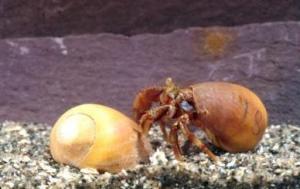The new study, conducted by Belfast University at Queen's University, shows that crabs not only suffer from pain and remember those memories.
The study, conducted by Professor Bob Elwood and Mirjam Appel of the School of Biological Sciences at Queen's, explored the reactions of mud crabs to light-intensity electric shocks. The study is published in Animal Behavior magazine.
Professor Elwood, who previously conducted a study on pandan pain tolerance, said his research emphasizes the need to understand the captured crustaceans for processing in the industry. How food industry is treated. House crabs do not have shells so they must live in other structures, often empty shells of molluscs. The wire is attached to the shell to transmit small electrical impulses to the abdomen of some crabs in the shell.
The only crabs that come out of the shell are those that are electrocuted, which indicates that the experience is very uncomfortable for them. At the same time, the experiment also showed that neurological treatment has occurred rather than simply a reflex.
It's thanks to liking certain types of shells than other types of shells. People also discovered that they would get out of the shells they least liked.
However, the main goal of this experiment was to transmit electrical impulses below the threshold that caused the crabs to crawl out of the shell to see what happened when a new shell was provided later. The crabs that were electrocuted but still trying to stay in the shell seemed to be able to remember this experience because they quickly moved to the new shell, surveyed the new shell and then quickly moved into this shell.
 On the picture is a crab at home. (Photo: Professor Bob Elwood)
On the picture is a crab at home. (Photo: Professor Bob Elwood)
Professor Elwood said: 'There has long been a debate about whether crustaceans, including crabs, pandan shrimp and lobsters, can feel pain. Previous studies tell us that they can detect harmful stimuli and withdraw from stimulating signals; but it's just a simple reflex that doesn't have an internal sense of discomfort that we consider to be painful. '
'This study proves that it is not a simple reflex, whereas crabs have traded the need for a quality shell with the need to avoid harmful agents. Such trade-offs occur in vertebrate animals, their responses to pain are controlled based on other needs'.
'For example, people can hold a hot plate with food but can drop a disc, which shows that we take into account different motivational requirements when responding to pain. This trade-off form has not previously been shown to exist in crustaceans. The results also match the notion that pain is experienced by these animals'.
Previous studies conducted by Queen's University also found that pandan shrimp had a longer rubbing action when one side of the beard was affected by mild acetic acid, but this action was reduced when it was numbed. the set. The results of both studies matched the observations of mammalian pain. But Professor Elwood said that unlike mammals, millions of crustaceans caught to serve the food and seafood industry every day are not much protected.
He added: 'More research is needed in this area when a big potential problem is being ignored. Legislation to protect crustaceans has been introduced but only takes into account scientific research. Millions of crustaceans are caught or cultivated to serve the food industry. There is no protection for these animals (exceptions in some Australian states) stemming from the thought that they cannot feel pain. With vertebrate animals, we are asked to be careful, I think this method should also be applied to crustaceans'.
Refer:
Robert W. Elwood, Mirjam Appel.Pain experience in hydrochloric crabs?Animal Behavior, 2009;DOI: 10.1016 / j.anbehav.2009.01.028
 Animal 'suffering' after hibernation
Animal 'suffering' after hibernation Why do goats climb well?
Why do goats climb well? Scientists were surprised to see chimpanzees eating turtles
Scientists were surprised to see chimpanzees eating turtles Giant catfish died deadly due to drought in Thailand
Giant catfish died deadly due to drought in Thailand